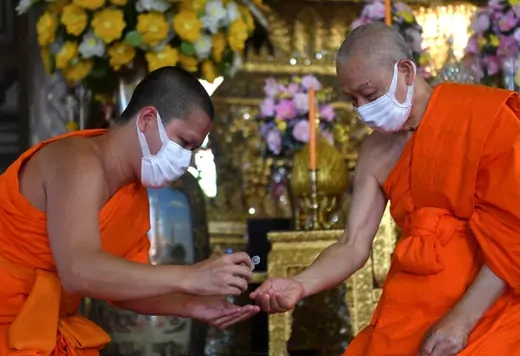The religious practices of hundreds of millions of people are undergoing profound changes in response to the COVID-19 pandemic caused by a new coronavirus. The crisis has prompted many religious leaders to appeal to their followers to not only take safety precautions but also to embrace their spirituality to help confront the health, social, and economic challenges ahead.
How has the pandemic disrupted religious observances?
Buddhists monks wearing protective masks due to the coronavirus outbreak use alcohol gel as they take part in a ceremony at Wat Suthat Thepwararam in Bangkok, Thailand.
In some cases, religious gatherings have proven to be hotbeds for outbreaks. Half of South Korea’s cases can be traced back to a meeting of the Shincheonji Church of Jesus, a Christian denomination. In Malaysia’s capital, Kuala Lumpur, several hundred Muslims who attended a mosque service contracted the virus, and in Washington, DC, a rector tested positive for the virus after performing communion at an Episcopalian church with more than five hundred congregants, all of whom were asked to self-quarantine for two weeks.
Many religious authorities are closing places of worship or limiting public gatherings. In an extraordinary gesture in February, Saudi Arabia banned foreign arrivals and halted visits to Mecca and Medina for umrah, a religious pilgrimage that Muslims can undertake at any time of year. Riyadh also briefly shuttered the Great Mosque in Mecca and the Prophet’s Mosque in Medina for disinfection. Many mosques have canceled Friday services, and calls to prayer in countries such as Kuwait and Malaysia have been altered to tell people to pray from home. Buddhist New Year celebrations, which often bring thousands of people together for public water fights and other events, have been canceled across South Asia.
Hindu devotees raise their hands daubed in colors as they pray at a temple during Holi celebrations in Ahmedabad, India.
Expressions of faith in some religious services emphasize close contact, such as hand-holding and sharing communion in Christian churches and touching or kissing religious objects at synagogues. Such practices are now being avoided in many religious spaces. At the same time, some religious orders have embraced technological solutions. The Roman Catholic Church, for instance, has begun livestreaming the Pope’s daily mass and Sunday sermon, and some parishes are offering drive-through confessions. A livestream of a service at the National Cathedral in Washington, DC, drew more than twenty-five thousand viewers earlier this month.
 Many of the world’s faithful have altered long-standing religious practices to avoid spreading the new coronavirus.
Many of the world’s faithful have altered long-standing religious practices to avoid spreading the new coronavirus.
